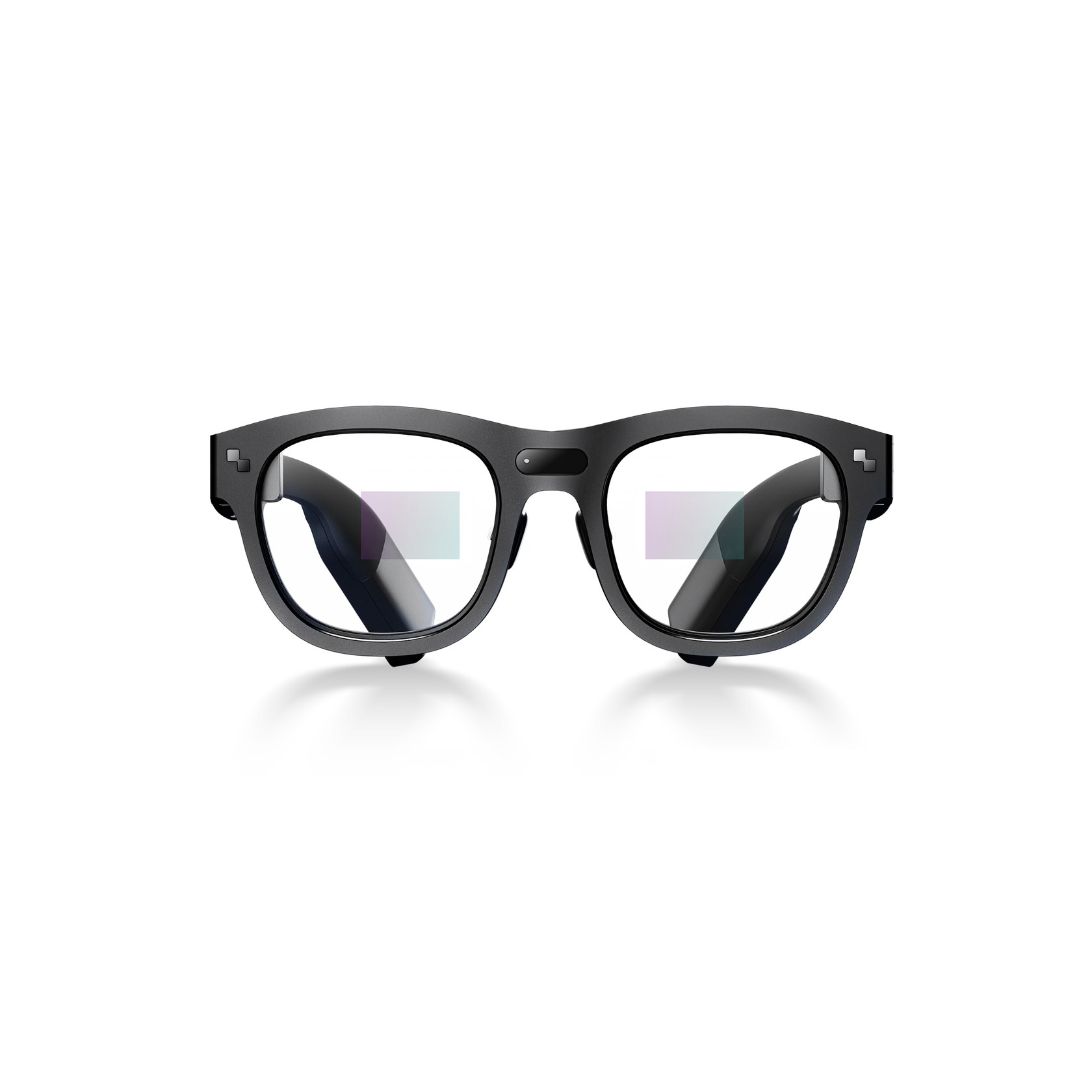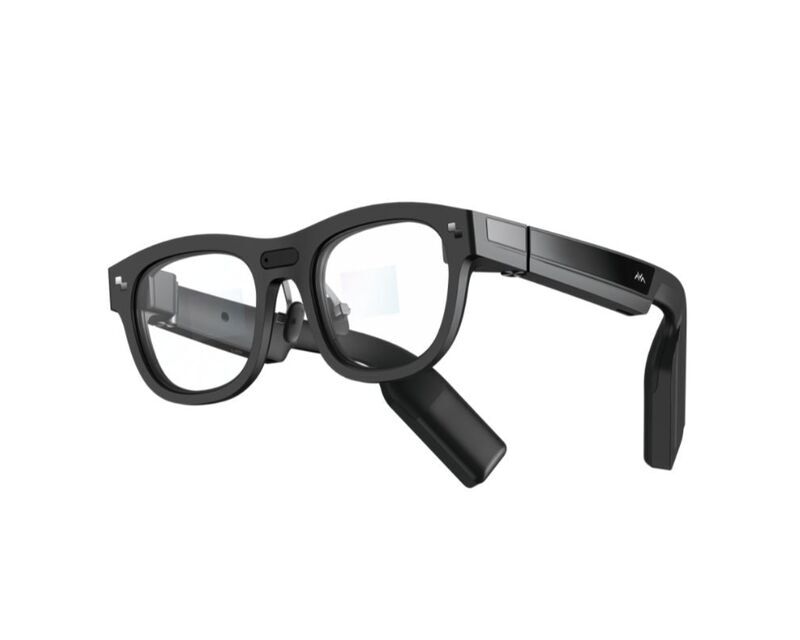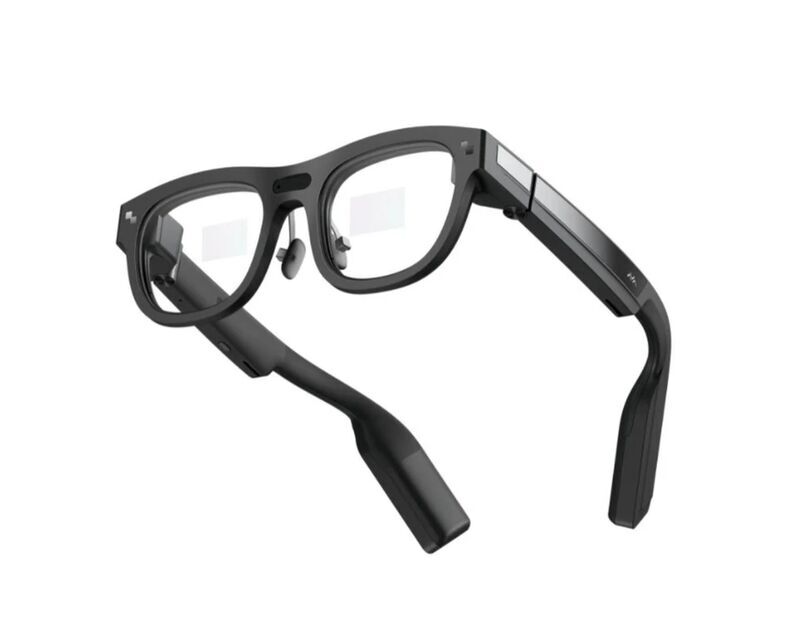In this review, we will discuss the new AR device, our own tests, and its compatibility with the IKSAR platform.
The new TCL RayNeo X2 from China is a fully standalone device that does not require constant use of a smartphone or an external computing unit. The RayNeo X2 glasses feature a powerful processor, sufficient memory, microphones, speakers, and, most importantly, two displays with a wide field of view.
The device is lightweight, weighing just over 100 grams. Externally, the TCL RayNeo X2 resembles regular vision glasses. Wearing them for extended periods is comfortable, with no discomfort or slipping off the nose. Thanks to interchangeable nose pads, the AR glasses can be adapted to fit the unique features of the user’s face. The frame is made from durable, high-quality materials, and although the manufacturer does not mention this in the specifications, the device can withstand occasional drops without affecting its functionality.
The Qualcomm Snapdragon XR2 processor ensures high performance, while 6GB of RAM and 128GB of internal storage allow for fast processing of large amounts of data. The high-quality 16MP camera, located on the frame between the lenses, allows for "first-person" content creation. Additionally, the device features Wi-Fi and Bluetooth modules for fast data transfer and connection to other devices, such as a smart ring or smartphones running iOS or Android.
The new TCL RayNeo X2 from China is a fully standalone device that does not require constant use of a smartphone or an external computing unit. The RayNeo X2 glasses feature a powerful processor, sufficient memory, microphones, speakers, and, most importantly, two displays with a wide field of view.
The device is lightweight, weighing just over 100 grams. Externally, the TCL RayNeo X2 resembles regular vision glasses. Wearing them for extended periods is comfortable, with no discomfort or slipping off the nose. Thanks to interchangeable nose pads, the AR glasses can be adapted to fit the unique features of the user’s face. The frame is made from durable, high-quality materials, and although the manufacturer does not mention this in the specifications, the device can withstand occasional drops without affecting its functionality.
The Qualcomm Snapdragon XR2 processor ensures high performance, while 6GB of RAM and 128GB of internal storage allow for fast processing of large amounts of data. The high-quality 16MP camera, located on the frame between the lenses, allows for "first-person" content creation. Additionally, the device features Wi-Fi and Bluetooth modules for fast data transfer and connection to other devices, such as a smart ring or smartphones running iOS or Android.

According to the manufacturer, the glasses are equipped with two full-featured displays built using Micro-LED waveguide technology, capable of transmitting over 16 million colors and with a brightness of up to 1500 nits. Our tests show excellent image quality. Users with vision impairments may face some difficulties, but AR glasses are quite comfortable to use with contact lenses.

The glasses support various control methods. Voice control is generally quite convenient to use; the manufacturer claims there are three microphones, but the active noise cancellation technology is not yet available, which means false voice command triggers may occur under certain circumstances, both from the wearer and people nearby.
Another control method is the touchpad on the device’s temples. It is responsive and easy to use. The TCL RayNeo X2 also comes with a smart ring, which works via Bluetooth and has its own touchpad and buttons.
Another control method is the touchpad on the device’s temples. It is responsive and easy to use. The TCL RayNeo X2 also comes with a smart ring, which works via Bluetooth and has its own touchpad and buttons.

The AR glasses have a power button for turning the device on/off and managing the sleep mode. To quickly set up Wi-Fi, you can connect to a smartphone running iOS or Android and use the manufacturer’s app to perform the necessary actions.
To save energy, the built-in 590 mAh battery automatically turns off the screen when removed from the head, thanks to an integrated sensor. The battery life in active mode with the IKSAR software is about 2.5 hours without recharging. One common issue with such compact devices is heating during prolonged use, especially in the arm of the glasses where the battery is located. We have not encountered this issue with the TCL RayNeo X2, which we consider a significant achievement for the manufacturer.
To save energy, the built-in 590 mAh battery automatically turns off the screen when removed from the head, thanks to an integrated sensor. The battery life in active mode with the IKSAR software is about 2.5 hours without recharging. One common issue with such compact devices is heating during prolonged use, especially in the arm of the glasses where the battery is located. We have not encountered this issue with the TCL RayNeo X2, which we consider a significant achievement for the manufacturer.

In our tests, with ambient temperatures ranging from -5°C to 0 °C, the battery life dropped to 1.5 hours. To ensure longer usage, an external power source (power bank) can be connected to the AR glasses via a wire. The glasses are charged using a magnetic USB-A cable, which is included with the device. The design does not allow for a replaceable battery. The manufacturer does not claim the device is dust- or waterproof, and it is not intended for continuous operation in aggressive environments.
The Chinese manufacturer offers its own mobile OS, RayNeo, based on AOSP, and development tools to create mobile apps from scratch specifically for this device. We had to work a bit to launch the ready-made mobile part of the IKSAR platform on the TCL RayNeo X2.
As a result, we successfully adapted the AR glasses to support all the features of the IKSAR platform and developed a way to work with each display separately. Thus, we can use the TCL RayNeo X2 not only in the classic binocular mode but also, upon user command, use just the left or right screen of the device, making it monocular. This can be convenient for certain application scenarios, as one display obstructs the physical world view less, while still displaying content in a size large enough for perception.
In our opinion, the affordable price, light weight, high performance, and wide field of view give the TCL RayNeo X2 significant competitive advantages for use in IKSAR software-based projects in various business scenarios.
The Chinese manufacturer offers its own mobile OS, RayNeo, based on AOSP, and development tools to create mobile apps from scratch specifically for this device. We had to work a bit to launch the ready-made mobile part of the IKSAR platform on the TCL RayNeo X2.
As a result, we successfully adapted the AR glasses to support all the features of the IKSAR platform and developed a way to work with each display separately. Thus, we can use the TCL RayNeo X2 not only in the classic binocular mode but also, upon user command, use just the left or right screen of the device, making it monocular. This can be convenient for certain application scenarios, as one display obstructs the physical world view less, while still displaying content in a size large enough for perception.
In our opinion, the affordable price, light weight, high performance, and wide field of view give the TCL RayNeo X2 significant competitive advantages for use in IKSAR software-based projects in various business scenarios.
